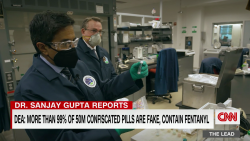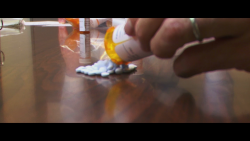Story highlights
There will be no additional federal funding directed under this order
The officials pushed back against the idea that Trump's order is less sweeping than what he promised
President Donald Trump declared the opioid epidemic a national public health emergency on Thursday, telling an audience in the East Room of the White House that “we can be the generation that ends the opioid epidemic.”
“This epidemic is a national health emergency,” he said. “Nobody has seen anything like what is going on now.”
He added: “As Americans, we cannot allow this to continue. It is time to liberate our communities from this scourge of drug addiction. Never been this way. We can be the generation that ends the opioid epidemic. We can do it.”
Trump, in a wide-ranging speech about opioids, stressed the need for further enforcement and linked his planned wall along the US-Mexico border with efforts to stem the tide of illegal drugs coming into the United States.
“An astonishing 90% of the heroin in America comes from south of the border – where we will be building a wall – which will greatly help in this problem,” he said.
Some experts are skeptical about the wall’s ability to fight the problem, given its roots in painkillers prescribed by doctors in the United States.
Trump also stressed the need to crack down on those Americans who are buying illegal drugs, stressing the need to link enforcement with stopping abuse in the first place.
“Every person who buys illicit drugs here in America should know that they are risking their futures, their families and even their lives,” he said. “Illegal drug use is not a victimless crime. There is nothing admirable, positive or socially desirable about it.”
Trump’s move is different from the broad order the President previewed over the last few months. On Thursday, the President directed acting Health Secretary Eric Hargan to declare a public health emergency under the Public Health Services Act – which directs federal agencies to provide more grant money to combat the epidemic – not a national emergency through the Stafford Disaster Relief and Emergency Assistance Act.
The difference between the two orders is money and scope. If Trump had used the Stafford Act, the federal government would have been able to tap into funds from the Federal Emergency Management Agency’s Disaster Relief Fund to combat opioids. A senior administration official, however, said the designation was not the right fit because the FEMA money is meant for natural disasters, not health emergencies.
Under the Public Health Services Act designation, no additional federal funding will automatically be directed to the crisis, said an official, but federal agencies will be directed to devote more grant money already in their budget to the problem and take “action to overcome bureaucratic delays and inefficiencies in the hiring process,” according to a fact sheet on Trump’s order.
The Trump administration will work with Congress to fund the Public Health Emergency fund and to increase federal funding in year-end budget deals currently being negotiated in Congress.
Trump called for creativity in trying to fight the opioid epidemic, even suggesting a “really tough, really big, really great” advertising campaign that would aim to convince people never to do drugs in the first place. That sort of strategy advocates for targeting kids and young adults with anti-drug messaging, evocative of the “Just Say No” ad campaign of the 1980s and early 1990s.
The President also personalized his message, telling the audience of Cabinet officials, lawmakers and families affected by the opioid epidemic that his older brother Fred Trump Jr.’s struggle with alcoholism taught him about curbing addiction.
“I had someone who guided me and he had a very, very tough life because of alcohol,” he said, adding that reaching young people and urging them never to start using drugs will make it “really, really easy” to fight the scourge.
Administration officials, pressed as to why Trump didn’t declare a nation disaster to combat the crisis, pushed back against the idea that Trump’s order is less sweeping than what he promised.
“Under the Stafford Act, as unfortunately we have seen on multiple occasions over the last several months, the Stafford Act is deigned to respond to mostly natural disasters that are (of a) very short time duration and a specific geographic region,” one official said, adding that the Trump administration believed the order under the Public Health Services Act is “a better use.”
Trump’s order will last 90 days and, according to another official, can be renewed every 90 days until the President believes it is no longer needed.
Since 1999, the number of American overdose deaths involving opioids has quadrupled. From 2000 to 2015, more than 500,000 people died of drug overdoses, and opioids account for the majority of those. Recently released numbers from the Centers for Disease Control and Prevention found that around 64,000 people died from drug overdoses in 2016.
Trump, after campaigning for president in part on fighting the scourge of opioid addiction, has long teased sweeping action.
The President told reporters in August that he would designate the epidemic a “national emergency” but failed to follow through. The lack of action, treatment advocates said, has deprived the fight against the deadly drugs a designation that would offer states and federal agencies more resources and power.
During an impromptu press conference in the White House Rose Garden last week, Trump said that he would officially declare the national emergency when asked why he had not followed through with his initial pledge.
And speaking with reporters on the South Lawn of the White House on Wednesday, Trump said he would have a “very big meeting on opioids” on Thursday and will be declaring the opioid epidemic a national emergency “in the very near future.”
Public health emergency vs. national emergency
The primary difference between the two designations is access to funding.
The designation Trump will announce Thursday does not allow the federal government to tap into FEMA’s Disaster Relief Fund and it is an open question whether Congress will offer more money to fund the Public Health Emergency fund, which Congress has not funded in recent years.
But multiple Obama administration health officials told CNN that they believe using the Public Health Services Act is the more appropriate avenue.
Using FEMA funds to combat the opioid crisis would be “a little bit like asking an engineer to bake a cake,” said Rafael Lemaitre, the former communications director for the White House Drug Policy Office under Obama.
“I do think the public health service act is more appropriate route to take than the Stafford Act designation,” he said. “I worked at FEMA for two years and dealt with multiple disasters. The Stafford Act is not structured to deal with a long term, complicated public health crisis like the opioid crisis.”
Lemaitre added that FEMA’s fund is “already running on fumes because of the three hurricanes” that hit this year.
Tom Coderre, a former senior official under in Obama’s Substance Abuse and Mental Health Services Administration office at HHS, echoed that sentiment.
“One of the things that I think is most beneficial part of having a public health emergency is you really can marshal public support and then you can bring all the resources of the federal government to bear on it, bringing people from all of the agencies to combat the issue,” he said.
Though both Lemaitre and Coderre said this step was important, both argued that it was not a “silver bullet solution to the opioid crisis.” That, they said, would be additional funding from Congress.
“A smarter play here would be for the administration to move beyond this declaration and pass the billions in funding needed to address this crisis. That is how you move the needle on this,” Lemaitre said.
2016 election
Shortly after taking office, Trump convened a White House commission to study the problem and provide recommendations. Earlier this year, despite then-Health and Human Services Secretary Tom Price saying it wasn’t needed, the commission recommended Trump declare a national emergency using either the Public Health Services Act or the Stafford Act.
“I commend the President on the bold action he is taking today by adopting the first recommendation” the commission made, New Jersey Gov. Chris Christie, the head of the panel, said Thursday.
The businessman-turned-politician made combating the opioid epidemic a top priority during the 2016 campaign.
The issue was elevated to such importance that during the closing moments of Trump’s 2016 campaign – when time is at its most precious – the Republican nominee headlined an opioid roundtable where he met face-to-face with those directly impacted by the issue.
“I just want to let the people of New Hampshire know that I’m with you 1,000%, you really taught me a lot,” he said before promising to help people who “are so seriously addicted.”
His actions as president, though, have left even members of his own commission with concerns.
Former Rep. Patrick Kennedy, a member of the President’s commission on opioid addiction, told CNN on Wednesday that he worries the President and his administration are using the opioid epidemic for photo ops.
“We don’t want any more photo-ops,” the former Democratic congressman from Rhode Island said. “I’m just speaking as an advocate, in this fight every single day as someone who is in recovery and someone who is an advocate. We don’t want any more visits to rehab centers and photo-ops, saying how courageous we are. Enough already. We want to save lives.”
























